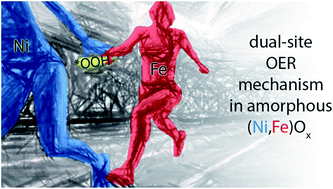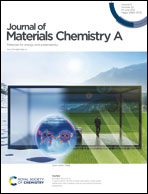Local structural changes in polyamorphous (Ni,Fe)Ox electrocatalysts suggest a dual-site oxygen evolution reaction mechanism†
Abstract
Amorphous nickel–iron mixed metal oxides have been shown to be extremely efficient oxygen evolution reaction (OER) electrocatalysts with good stability in alkaline reaction conditions. Thus, they offer an economical alternative to expensive conventional platinum- or iridium-based OER catalysts and could provide a crucial step towards a hydrogen-based energy economy. These favorable properties are presumably due to a synergistic effect between Fe and Ni. However, these synergistic effects strongly depend on the local structure of the catalyst and their origin – and its relation to the local structure – are still not fully understood. In this work we present a study of the thermal annealing induced structural evolution of amorphous (Ni,Fe)Ox thin films, and correlate this evolution to their OER catalytic capabilities. Samples are X-ray amorphous at low annealing temperatures. However, analysis of the X-ray absorption spectra reveals local structural transitions in all samples – before the onset of crystallization – providing evidence of polyamorphism. Transitions of the local Ni and Fe environments occur at distinctly different temperatures and coincide with a stepwise increase in the catalytic activation potential (OER thermodynamics) and the Tafel slope (OER kinetics), respectively. We previously have attributed the increase in onset potential to a change in active site in NiOx at the phase transition temperature; considering that the mixed metal oxides' onset potentials exhibit the same behavior with annealing temperature (Tanneal), we conclude that the potential-determining OER reaction step must occur at a Ni site. Similarly, the reaction kinetics change at the same annealing temperature as the local Fe environment; we thus infer that the rate-determining step occurs at a Fe site. To reconcile these observations we put forward a dual-site OER reaction mechanism with potential- and rate-determining steps happening at Ni and Fe sites, respectively. This synergistic effect is ultimately responsible for the superior OER performance of many (Ni,Fe)Ox catalysts. At higher annealing temperatures, the synergistic effect is suppressed, possibly by phase separation into NiOx and FeOx phases, as suggested by our X-ray diffraction results.



 Please wait while we load your content...
Please wait while we load your content...